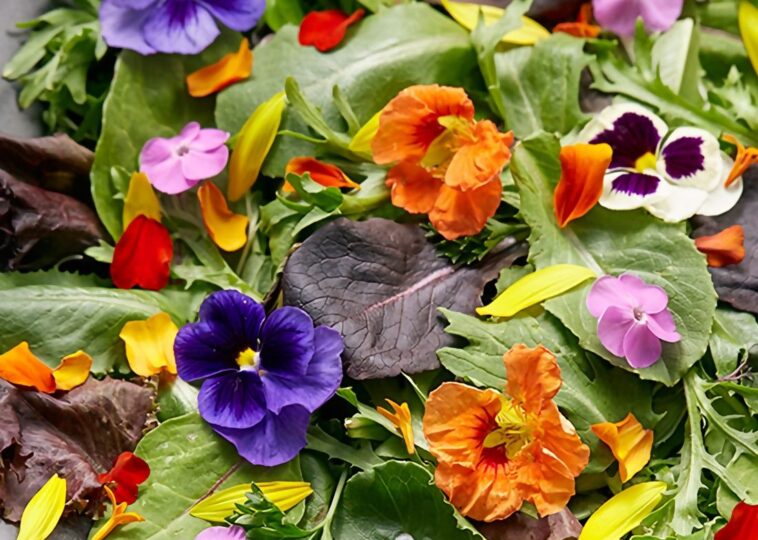Beyond Beauty: Exploring the Delicious World of Edible Flowers

Contents [hide]
Have you ever considered that those vibrant blossoms you admire in gardens or wild meadows could also tantalize your taste buds? Welcome to the delightful realm of edible flowers, where visual appeal meets culinary creativity.
These floral wonders aren’t just for decoration; they can transform your dishes into gastronomic delights, adding a flavor, a splash of color, and even a nutritional boost. Beyond their aesthetic appeal and taste, many edible flowers pack a nutritional punch. The versatility of edible flowers knows no bounds. Are you curious to explore this floral frontier?
Borage: The Vibrant Starflower

Borage, often called starflower, thrives in the Mediterranean but adapts well to garden cultivation. Its striking blue blooms dominate, occasionally punctuated by pink or white varieties. Preferring temperate climates, borage blooms from June through September. Beyond its ornamental appeal, borage yields valuable seed oil prized for its health benefits and mild cucumber-like taste.
Borage offers a fresh, vegetable-like flavor in culinary realms, enhancing German and Italian dishes. Whether in garden beds or gourmet kitchens, borage stands out as a star among edible flowers, blending beauty with culinary creativity.
Hibiscus: From Tea to Treats

Hibiscus, a tropical and subtropical gem, graces gardens worldwide with its stunning colors, reds, blues, whites, and pinks. Beyond its ornamental beauty, hibiscus offers a wealth of culinary delights and health benefits. Perhaps most famously, hibiscus lends its petals to a tart and refreshing tea enjoyed globally.
Known for its distinctive crimson hue, hibiscus tea delights with a tangy flavor profile enriched with antioxidants and a healthy dose of vitamin C. Dried and sugar-coated hibiscus flowers transform into delightful candies, offering a sweet treat that retains the flower’s natural tanginess.
Zucchini Blossoms Delicacy

Zucchini blossoms, a seasonal delight cherished in culinary traditions worldwide, are prominently cultivated in regions like Italy and the United States. The versatility of zucchini blossoms extends from salads to savory dishes. In Italian cuisine, a popular preparation involves stuffing the blossoms with Parmesan and ricotta cheeses and herbs, then lightly battering and pan-frying them to crispy perfection.
Beyond frying, zucchini blossoms grace gourmet pizzas as a flavorful topping, adding a touch of elegance and a burst of freshness. Commercially, these blossoms are cultivated to meet market demands, emphasizing their economic importance and gastronomic appeal. In salads, zucchini blossoms offer a refreshing contrast, their tender petals imparting a subtle crunch and a hint of squash sweetness.
Culinary Delights of Lavender

Lavender, known for its violet, blue, lilac, and purple-blue hues, thrives in temperate climates worldwide. Its variants include English and French lavender, reflecting their regional origins. Lavender buds are prized for making fragrant teas and are a favorite among beekeepers for producing monofloral honey.
Professional chefs experiment with lavender buds in the kitchen, blending them into cheeses like sheep and goat milk varieties. They also infuse them into green and herbal teas for a unique flavor profile. In the United States, cultural cuisines like lavender-infused marshmallows and syrupy scones have gained popularity, showcasing lavender’s ability to transform traditional treats into something uniquely delightful.
Chrysanthemum: A Floral Feast

Chrysanthemums, beloved for their vibrant blooms, also offer a culinary adventure that spans continents. Chrysanthemum buds, known as tong hao in Chinese, are the stars of many dishes. Depending on the variety, from hearty casseroles to fragrant teas, these buds lend a tangy to peppery flavor. Dried chrysanthemum adds an aromatic twist to teas, making them both flavorful and soothing.
Beyond taste, chrysanthemums pack a nutritional punch. Integrating them into meals not only enhances flavor but also boosts nutritional value. Chrysanthemums harmonize beautifully with a range of flavors. In Japan, the spring variety, shungiku, stars in sukiyaki hot pots, adding a fresh, herbal note to the savory broth.
Pansy: A Floral Marvel

Pansies, with their vibrant colors and delicate petals, thrive in cool climates, making them a favorite for garnishing salads and adding a whimsical touch to desserts. Whether speckled or solid-hued, these flowers bring brightness to any culinary creation. In their raw form, pansies offer a crisp, lettuce-like taste with a hint of spice.
Candying pansies preserve their beauty and turn them into versatile ingredients for cookies and other baked goods. Beyond their culinary uses, pansies boast antimicrobial properties that aid in healing wounds and fighting infections.
Viola Flowers

Viola flowers, with their vibrant hues ranging from sunny yellows to deep blues, offer more than just visual appeal. They bring a burst of flavor to your table. These delicate blooms boast a smooth texture and a subtly sweet fragrance that resembles honey, making them a delightful addition to various dishes and beverages.
Viola flowers are not just pretty; they’re packed with vitamins and antioxidants that can bolster your immune system. White and yellow violas are particularly rich in proteins and antioxidants, while red violas contain high levels of carotenoids and carbohydrates.
Nasturtium: the Edible Gem

Nasturtiums aren’t just pretty flowers; they’re a culinary delight that adds zest and color to your dishes. Their bright yellow to red blooms offer a spicy kick, perfect for enhancing salads and desserts. Whether enjoyed raw or cooked, these versatile flowers bring a unique flavor profile that evolves as they mature from bud to bloom.
In addition to their peppery taste, nasturtiums offer a light, sweet nectar packed with vitamins B1, B2, and C and essential minerals like iron, calcium, and manganese. Beyond garnishing salads, nasturtium flowers can be used creatively in vinegar, sauces, and infused butter, adding flavor and a vibrant hue to culinary creations.
Marigold: Flavor and Color

Marigolds, those vibrant summer blooms adorning many gardens, are not just for aesthetic pleasure; they also pack a flavorful punch in the culinary world. These annual plants, ranging in hues from bright orange to sunny yellow, offer more than just visual appeal. Marigold flowers, known for their mild citrus to peppery taste, are prized for their culinary versatility.
Varieties like Drop shots, lemon and tangerine gem, and Mexican tarragon marigolds are explicitly cultivated for their delightful flavors. Harvesting them at their peak is crucial, as their taste can become bitter with age. However, not all marigold varieties are edible, emphasizing the importance of selective cultivation for culinary purposes.
Edible Roses

Roses aren’t just beautiful to look at; they can also tantalize your taste buds in ways you might not expect. Rose petals find their way into culinary creations, from herbal teas and jams to vibrant dessert garnishes and refreshing salads. They are also transformed into luxurious rose syrups, perfect for cocktails and as a natural sweetener in baking.
Chefs often use rose petals to infuse beverages with their distinct floral aroma, adding a sophisticated touch to drinks. For those with a green thumb and a penchant for culinary experimentation, consider growing edible rose varieties like Lady of Shalott, Crown Princess Margareta, Woods’ Rose, and Alba in your garden.


